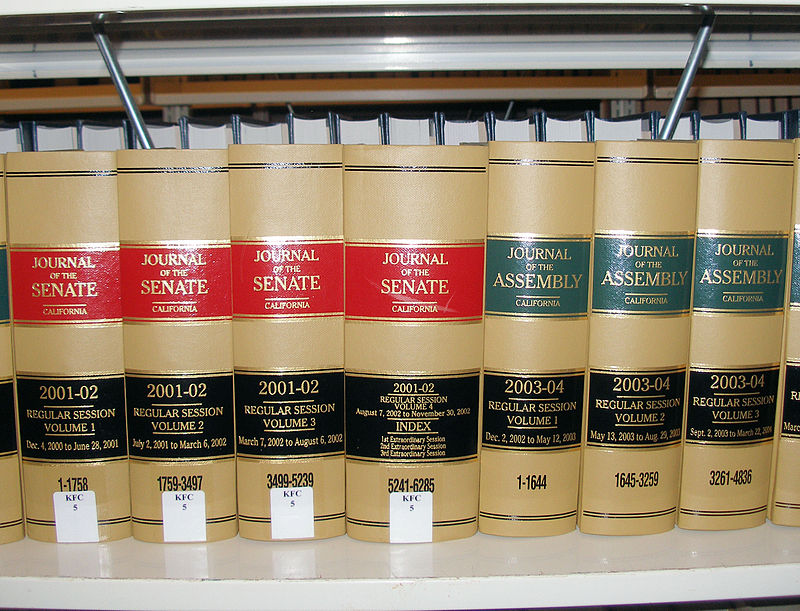
Journals of the California Legislature. (Photo: Wikipedia)
The Purposes of California’s Administrative Procedure Act
There exists no central office in state government with the power and duty to review regulations
By Chris Micheli, November 2, 2021 2:26 am
California’s Administrative Procedure Act (APA), like its federal counterpart, provides the formal procedures by which the executive branch agencies must conduct their rulemaking activities. What is the purpose of the APA according to the courts of this state?
There are essentially two main purposes of the APA. The first is to give notice to persons affected by a regulation. The second is to give them a voice in its creation. Missionary Guadalupanas of Holy Spirit, Inc. v. Rouillard (2019) 251 Cal.Rptr. 3rd 1, review denied; Morning Start Company v. State Board of Equalization (2006) 38 Cal. 4th 324; Reilly v. Superior Court (2013) 57 Cal. 4th 641
Other courts have stated these two purposes similarly. For example, one appeals court described a major purpose of the APA is to provide a procedure for persons or entities affected by a regulation to be heard on the merits in its creation, and to have notice of the law’s requirements so that they can conform their conduct accordingly. Morales v. California Department of Corrections and Rehabilitation (2008) 168 Cal.App. 4th 729
Some courts have specified a third purpose. For example, one appellate court described the purpose of the APA as advancing meaningful public participation in the adoption of administrative regulations by state agencies and creating an administrative record assuring effective judicial review. Baskin v. Hughes Realty, Inc. (2018) 235 Cal.Rptr. 3rd 589; POET, LLC v. State Air Resources Board (2013) 218 Cal.App. 4th 681, review denied
In addition to these main purposes, there were purposes stated by the Legislature, such as that the APA was created because the Legislature perceived there existed too many regulations imposing greater than necessary burdens on the state and particularly upon small businesses. As a result, a formal review process of proposed regulations was in order. California Forestry Association v. California Fish and Game Commission (2007) 156 Cal.App. 4th
In addition, some state agencies were viewed as adopting regulations that did not provide notice or an opportunity to be heard, which are called “underground regulations” because they are adopted without following formal procedures. So, one appellate court described that APA as being designed in part to prevent the use by administrative agencies of “underground” regulations, and it is the courts, not administrative agencies, which enforce that prohibition. California Advocates for Nursing Home Reform v. Bonta (2003) 106 Cal.App. 4th 498
As part of California’s APA, the Legislature enacted a number of findings and declarations. These are contained in the first two sections of the APA statutes found in the California Government Code. Section 11340 provides the following seven provisions:
The Legislature finds and declares as follows:
(a) There has been an unprecedented growth in the number of administrative regulations in recent years.
(b) The language of many regulations is frequently unclear and unnecessarily complex, even when the complicated and technical nature of the subject matter is taken into account. The language is often confusing to the persons who must comply with the regulations.
(c) Substantial time and public funds have been spent in adopting regulations, the necessity for which has not been established.
(d) The imposition of prescriptive standards upon private persons and entities through regulations where the establishment of performance standards could reasonably be expected to produce the same result has placed an unnecessary burden on California citizens and discouraged innovation, research, and development of improved means of achieving desirable social goals.
(e) There exists no central office in state government with the power and duty to review regulations to ensure that they are written in a comprehensible manner, are authorized by statute, and are consistent with other law.
(f) Correcting the problems that have been caused by the unprecedented growth of regulations in California requires the direct involvement of the Legislature as well as that of the executive branch of state government.
(g) The complexity and lack of clarity in many regulations put small businesses, which do not have the resources to hire experts to assist them, at a distinct disadvantage.
In addition, Section 11340.1 provides the following additional statements:
(a) The Legislature therefore declares that it is in the public interest to establish an Office of Administrative Law which shall be charged with the orderly review of adopted regulations. It is the intent of the Legislature that the purpose of such review shall be to reduce the number of administrative regulations and to improve the quality of those regulations which are adopted. It is the intent of the Legislature that agencies shall actively seek to reduce the unnecessary regulatory burden on private individuals and entities by substituting performance standards for prescriptive standards wherever performance standards can be reasonably expected to be as effective and less burdensome, and that this substitution shall be considered during the course of the agency rulemaking process. It is the intent of the Legislature that neither the Office of Administrative Law nor the court should substitute its judgment for that of the rulemaking agency as expressed in the substantive content of adopted regulations. It is the intent of the Legislature that while the Office of Administrative Law will be part of the executive branch of state government, that the office work closely with, and upon request report directly to, the Legislature in order to accomplish regulatory reform in California.
(b) It is the intent of the Legislature that the California Code of Regulations made available on the Internet by the office pursuant to Section 11344 include complete authority and reference citations and history notes.
As a result, there are a number of legislative findings and declarations regarding the necessity of the APA in this state, as well as clear statements of the purpose of the APA from the courts.
- Enforcement of Labor Commissioner Judgments - December 6, 2025
- Effect of Emancipation - December 6, 2025
- Harbor Commissions in California - December 5, 2025




